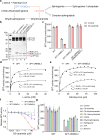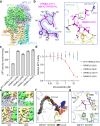Ceramide sensing by human SPT-ORMDL complex for establishing sphingolipid homeostasis
- PMID: 37308477
- PMCID: PMC10261145
- DOI: 10.1038/s41467-023-39274-y
Ceramide sensing by human SPT-ORMDL complex for establishing sphingolipid homeostasis
Abstract
The ORM/ORMDL family proteins function as regulatory subunits of the serine palmitoyltransferase (SPT) complex, which is the initiating and rate-limiting enzyme in sphingolipid biosynthesis. This complex is tightly regulated by cellular sphingolipid levels, but the sphingolipid sensing mechanism is unknown. Here we show that purified human SPT-ORMDL complexes are inhibited by the central sphingolipid metabolite ceramide. We have solved the cryo-EM structure of the SPT-ORMDL3 complex in a ceramide-bound state. Structure-guided mutational analyses reveal the essential function of this ceramide binding site for the suppression of SPT activity. Structural studies indicate that ceramide can induce and lock the N-terminus of ORMDL3 into an inhibitory conformation. Furthermore, we demonstrate that childhood amyotrophic lateral sclerosis (ALS) variants in the SPTLC1 subunit cause impaired ceramide sensing in the SPT-ORMDL3 mutants. Our work elucidates the molecular basis of ceramide sensing by the SPT-ORMDL complex for establishing sphingolipid homeostasis and indicates an important role of impaired ceramide sensing in disease development.
© 2023. The Author(s).
Conflict of interest statement
The authors declare no competing interests.
Figures







Similar articles
-
The ORMDL/Orm-serine palmitoyltransferase (SPT) complex is directly regulated by ceramide: Reconstitution of SPT regulation in isolated membranes.J Biol Chem. 2019 Mar 29;294(13):5146-5156. doi: 10.1074/jbc.RA118.007291. Epub 2019 Jan 30. J Biol Chem. 2019. PMID: 30700557 Free PMC article.
-
Mechanism of sphingolipid homeostasis revealed by structural analysis of Arabidopsis SPT-ORM1 complex.Sci Adv. 2023 Mar 29;9(13):eadg0728. doi: 10.1126/sciadv.adg0728. Epub 2023 Mar 29. Sci Adv. 2023. PMID: 36989369 Free PMC article.
-
CRISPR/Cas9 deletion of ORMDLs reveals complexity in sphingolipid metabolism.J Lipid Res. 2021;62:100082. doi: 10.1016/j.jlr.2021.100082. Epub 2021 Apr 30. J Lipid Res. 2021. PMID: 33939982 Free PMC article.
-
Sphingolipid homeostasis: How do cells know when enough is enough? Implications for plant pathogen responses.Plant Physiol. 2024 Dec 23;197(1):kiae460. doi: 10.1093/plphys/kiae460. Plant Physiol. 2024. PMID: 39222369 Review.
-
Regulation of de novo sphingolipid biosynthesis by the ORMDL proteins and sphingosine kinase-1.Adv Biol Regul. 2015 Jan;57:42-54. doi: 10.1016/j.jbior.2014.09.002. Epub 2014 Sep 17. Adv Biol Regul. 2015. PMID: 25319495 Review.
Cited by
-
Innovations in Antifungal Drug Discovery among Cell Envelope Synthesis Enzymes through Structural Insights.J Fungi (Basel). 2024 Feb 22;10(3):171. doi: 10.3390/jof10030171. J Fungi (Basel). 2024. PMID: 38535180 Free PMC article. Review.
-
A sphingolipid rheostat controls apoptosis versus apical cell extrusion as alternative tumour-suppressive mechanisms.Cell Death Dis. 2024 Oct 14;15(10):746. doi: 10.1038/s41419-024-07134-2. Cell Death Dis. 2024. PMID: 39397024 Free PMC article.
-
Structure and mechanism of a eukaryotic ceramide synthase complex.EMBO J. 2023 Dec 11;42(24):e114889. doi: 10.15252/embj.2023114889. Epub 2023 Nov 13. EMBO J. 2023. PMID: 37953642 Free PMC article.
-
Human genetic defects of sphingolipid synthesis.J Inherit Metab Dis. 2025 Jan;48(1):e12745. doi: 10.1002/jimd.12745. Epub 2024 May 5. J Inherit Metab Dis. 2025. PMID: 38706107 Free PMC article. Review.
-
Fine-tuned protein-lipid interactions in biological membranes: exploration and implications of the ORMDL-ceramide negative feedback loop in the endoplasmic reticulum.Front Cell Dev Biol. 2024 Aug 7;12:1457209. doi: 10.3389/fcell.2024.1457209. eCollection 2024. Front Cell Dev Biol. 2024. PMID: 39170919 Free PMC article.
References
Publication types
MeSH terms
Substances
Grants and funding
LinkOut - more resources
Full Text Sources
Medical
Molecular Biology Databases
Research Materials
Miscellaneous

